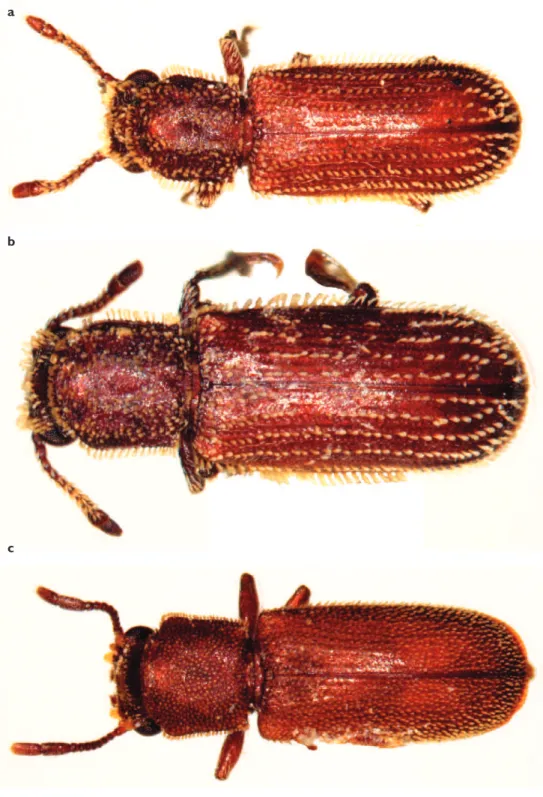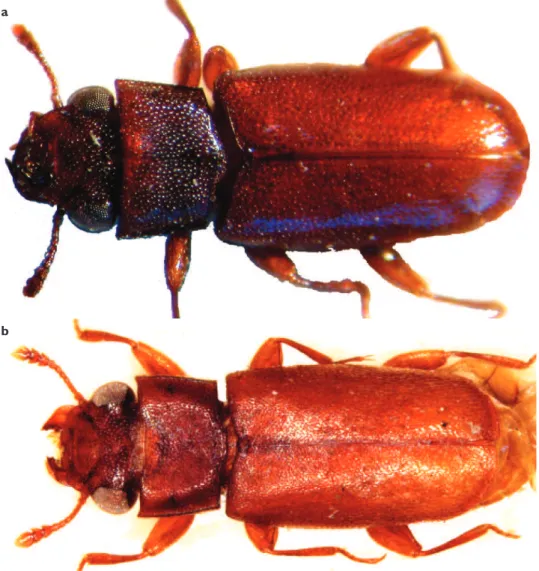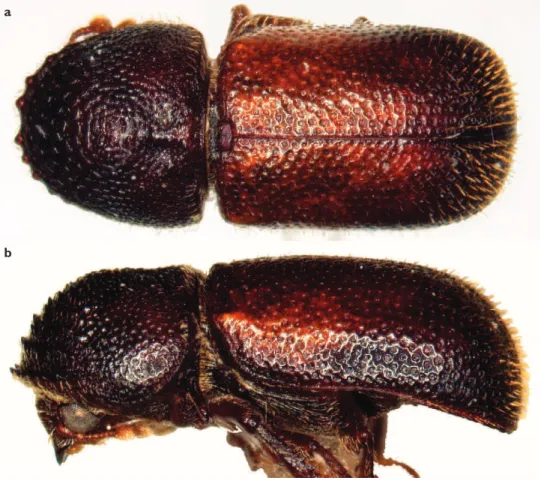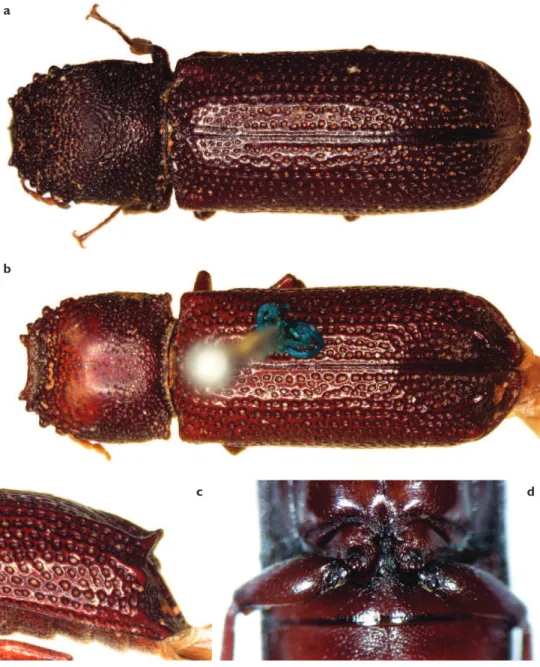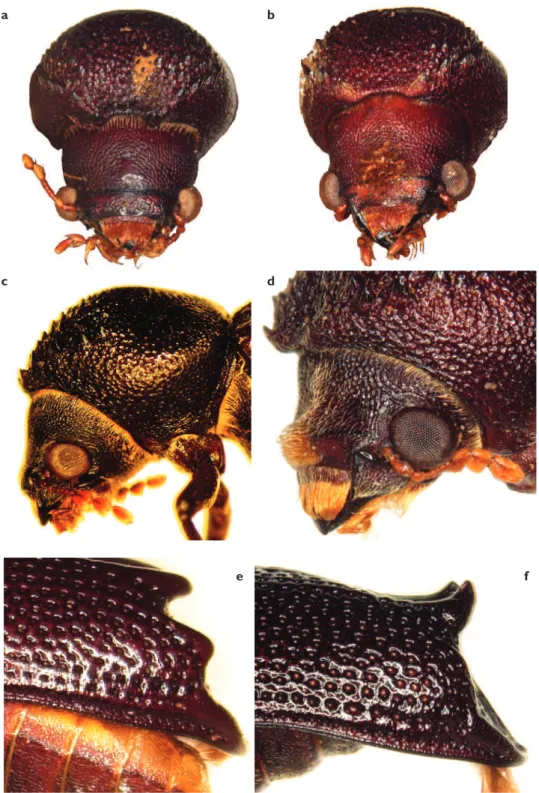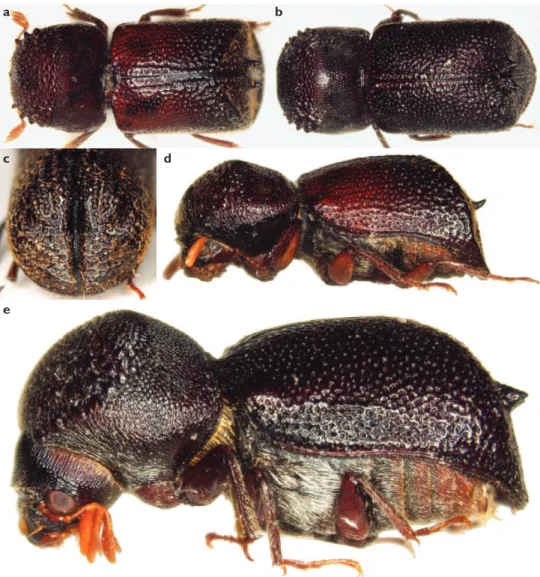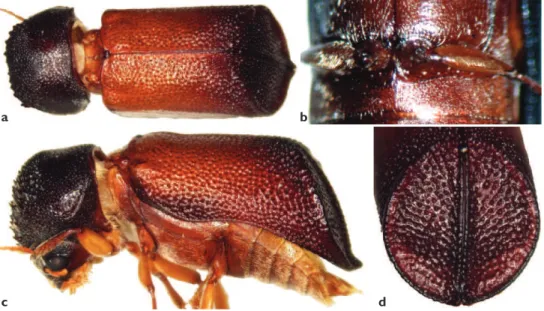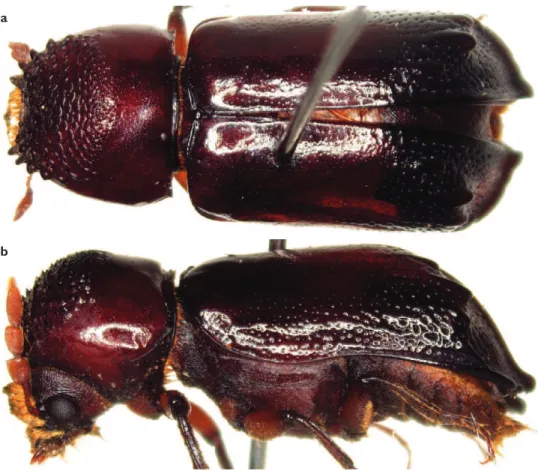An illustrated key to powder post beetles
(Coleoptera, Bostrichidae) associated with
rubberwood in Thailand, with new records and
a checklist of species found in Southern Thailand
Wisut Sittichaya1, Roger A. Beaver2, Lan-Yu Liu3, Aran Ngampongsai1
1 Department of Pest Management, Faculty of Natural Resources, Prince of Songkla University, Hat Yai, Songkhla, h ailand 90112 2 161/2 Mu 5, Soi Wat Pranon, T. Donkaew, A. Maerim, Chiangmai, h ailand 50180 3 Department of Science Education, National Museum of Natural Science, One Guancian Road, Taichung, Taiwan 404
Corresponding author: Wisut Sittichaya (wisut.s@psu.ac.th)
Academic editor:Terry Erwin | Received 26 January 2009 | Accepted 24 June 2009 | Published 30 October 2009
Citation: Sittichaya W et al. (2009) An illustrated key to powder post beetles (Coleoptera, Bostrichidae) associated with rubberwood in h ailand, with new records and a checklist of species found in Southern h ailand. ZooKeys 26: 33–51.
doi: 10.3897/zookeys.26.88
Abstract
An illustrated key to seventeen species of Bostrichidae recorded in association with rubberwood in h ai-land is provided. A checklist is given of nine species infesting rubberwood sawn timber in sawmills in southern h ailand, with information on distribution, host trees and biology. h ree species are recorded for the i rst time from h ailand: Cephalotoma tonkinea Lesne, Lyctoxylon dentatum (Pascoe), and Minthea reticulata Lesne.
Keywords
Bostrichidae, h ailand, rubber wood, Hevea brasiliensis, key
Introduction
Rubberwood (Hevea brasiliensis Muell. Arg.) is an environmentally friendly wood source, and is an important raw material for wood industries in South and Southeast Asian countries (Edwin and Pillai 2004, Hong 1996, Royal Forest Department of h ailand 2005). It is a non-durable wood, extremely susceptible to staining fungi as
www.pensoftonline.net/zookeys
Copyright W. Sittichaya et al. This is an open access article distributed under the terms of the Creative Commons Attribution License, which permits unrestricted use, distribution, and reproduction in any medium, provided the original author and source are credited.
well as insect attack due to its high starch content and low wood extractives (Akhter 2005, CIRAD 2003, Wong et al. 2005). h e major insect pests of dried rubberwood sawn timber are powder post beetles belonging to the family Bostrichidae. h ey are economically important beetles that can extensively damage dried and seasoned wood and wooden artifacts through the boring behavior of both adults and larvae (Akhter 2005, Crei eld 1991, Gerberg 1957, Ivie 2002, Peters et al. 2002). In this paper we have followed the classii cation of the most recently published catalogue of the Bos-trichidae (Borowski and Węgrzynowicz 2007). Adults and larvae of most subfamilies of Bostrichidae both bore into and feed on the wood. One exception is the members of the subfamily Lyctinae in which only the larvae are wood feeders (Halperin and Geis 1999, Liu et al. 2008b). In h ailand, Kamnerdratana et al. (1970) reported two powder post beetles, Sinoxylon anale Lesne and S. crassum Lesne, infesting rubber logs in southern h ailand. Hutacharern and Tubtim (1995) in their checklist of forest in-sect pests of h ailand, added 10 species associated with Hevea brasiliensis: Apoleon edax
Gorham, Dinoderus spp., Heterobostrychus aequalis (Waterhouse), H. pileatus Lesne, H. unicornis (Waterhouse), Sinoxylon rui corne Fåhraeus, Xylothrips l avipes (Illiger), Lyctus africanus Lesne, Lyctus sp. and Minthea rugicollis (Walker). In this paper, we provide an illustrated key to all 17 species of Bostrichidae that have been recorded in associa-tion with rubberwood in h ailand. We provide a checklist with notes on distribution and host plants of nine species of bostrichids that infested rubberwood sawn timber in sawmills in southern h ailand, seven of which are newly reported from rubberwood, and three of which are newly recorded from h ailand.
Key to the Species of Bostrichidae Infesting Rubberwood Sawn Timber in Thailand
1. Head directed to the front, fully visible from above ...2
− Head covered by pronotum, not visible from above ...9
2. Pronotum not l attened, rounded at sides without lateral margins, disc of pronotum tuberculate (Fig. 5). Antenna 10-segmented with elongate 3-seg-mented club. Larger species, 10 – 21 mm long. (Dysidinae) ... ...Apoleon edax Gorham
− Pronotum more or less l attened with complete lateral margins, disc not tu-berculate (Figs 1–3). Antenna 11-segmented usually with 2-segmented club (Fig.12f–h), if 3-segmented, segments less elongate (Fig. 12i, j). Smaller spe-cies, at most 4 mm long. (Lyctinae) ...3
3. Antennal club 2-segmented. Body moderately l attened. Elytral punctures usually seriate. (Figs 1–3) (Lyctini) ...4
– Antennal club 3-segmented. Body very strongly l attened. Elytral punctures confused. (Fig. 4) (Trogoxylini) ...8
– Antennal club with one or both antennomeres greatly elongated (Fig. 12g, h) ...6
5. Pronotum and elytra with short, i ne, yellowish hairs, elytra usually brightly shining (Fig. 1) ...Lyctus africanus Lesne
− Pronotum and elytra densely covered with long, coarse, curved hairs, not brightly shining (Fig. 2) ...Lyctus tomentosus Reitter
6. Antennal club with both segments elongate, subequal in length, segments of funicle without semierect, scale-like setae (Fig. 12h); elytra with short, thick, semierect setae, not arranged in regular rows (Fig. 3c) ... ...Lyctoxylon dentatum (Pascoe)
– Antennal club with only terminal segment elongate, segments of funicle with semierect, scale-like setae (Fig. 12g); elytra with regular rows of wide, l at-tened, erect, scale-like setae. (Minthea) ...7
7. h oracic fovea deeply and distinctly reticulate; lateral margin of pronotum distinctly toothed and with from 7 to 12 stif narrow scale-like setae (Fig. 3a) ...Minthea reticulata Lesne
– h oracic fovea punctate, not distinctly reticulate; lateral margin of pronotum rather smooth and with from 13 to 19 broad scale-like setae (Fig. 3b) ... ...Minthea rugicollis (Walker)
8. Body strongly shining. Punctures on pronotum and elytra less dense, separat-ed by much more than their own diameter. Pronotum with oblique, elongate rugulosities at sides near posterior angles (Fig. 4a). Antenna (Fig. 12i) ... ...Lyctoderma coomani Lesne
– Body dull or weakly shining. Pronotum and elytra very densely punctured, the punctures separated by less than their own diameter. Pronotum without oblique rugulosities near posterior angles (Fig. 4b). Antenna (Fig. 12j) ... ...Cephalotoma tonkinea Lesne
9. Pronotum rounded anteriorly without larger hooks or teeth at anterior an-gles. Protibia with 1 apical spine; i rst tarsomere subequal to second. (Dino-derinae). Scutellum transversely rectangular; pronotum with an obvious pair of foveae near base (Fig. 6) ...Dinoderus minutus (Fabricius)
– Pronotum l attened anteriorly often with hooks or teeth near the anterior angles (Figs 7–8). Protibia with 2 apical spines; i rst tarsomere very much shorter than the second. (Bostrichinae) ...10
10. Intercoxal process of i rst abdominal ventrite forming a vertical lamina (Fig. 10b). Metepisternum narrowed posteriorly so that metepimeron nearly touches metasternum (Xyloperthini) ...11
– Intercoxal process of i rst abdominal ventrite broader and with a ventral face (Fig. 7d). Metepisternum more broadly truncate behind with metepimeron widely separated from metasternum ...12
the margins, coarsely punctured above, more i nely below. (Fig. 11) ... ...Xylothrips l avipes (Illiger)
– Antenna 9-segmented, i rst and second segments of antennal club transverse (Fig. 12d). Anterolateral part of pronotum and basal part of pronotal disk punctured. Elytral declivity without costae, strongly punctured throughout. (Fig. 10) ...Xylopsocus capucinus (Fabricius)
12. Segments of antennal club l abellate (Fig.12e). Mandibles short, blunt, trun-cate at apices which meet in midline. (Sinoxylini: Sinoxylon)...13
– Segments of antennal club not l abellate (Fig.12b). Mandibles long, pointed at apices, almost always crossing in mid-line. (Bostrichini: Heterobostrychus) ...15
13. Teeth on elytral declivity contiguous, inserted on sutural interstriae, laterally compressed, triangular, with pointed tips, a prominent costa present on the lateral margin of the declivity at the same level, and another weaker costa more apically and laterally (Fig. 9c). Larger species, 7–9 mm long ... ...Sinoxylon crassum Lesne
– Teeth on elytral declivity not contiguous, inserted lateral to sutural inter-striae, lateral margin of declivity without costae. Smaller species, up to 6 mm long ...14
14. Elytral disc angularly separated from declivity; elytral margins carinate be-low, costate above, not rounded; submarginal carina along lateral margin of elytra curving dorsally at its posterior end to join carina forming lower margin of elytral declivity. Punctures of elytral disc increasing in size poste-riorly, very coarse at upper margin of declivity. (Fig. 9a, d) ... ...Sinoxylon anale Lesne
− Elytral disc curving gradually into declivity; declivital margins rounded; sub-marginal carina along lateral margin of elytra continues to run parallel to elytral margin to reach suture. Punctures of elytral disc not greatly increasing in size towards declivity. (Fig. 9b, e) ...Sinoxylon unidentatum (F.)
15. Posterior angles of pronotum lobed and projecting. Posterior part of prono-tum with large, deep punctures. Male with two tubercles on elytral declivity, the outer forming an elongate costa, the inner forming a strong, pointed tooth directed inwardly and upwardly (Fig.7c); frons without a nearly im-punctate shining area in middle. Female without strong tubercles on elytral declivity, emargination between anterior angles of pronotum broad, extend-ing about three quarters of distance between eyes; frons without a tuft of hairs.(Fig. 7) ...Heterobostrychus aequalis (Waterhouse)
− Posterior angles of pronotum rounded, at most slightly projecting. Posterior part of pronotum without large, deep punctures. Male frons with a shining almost impunctate area in middle. Female frons with a tuft of hairs; emar-gination between anterior angles of pronotum narrower ...16
hairs of frontal tuft shorter and sparser on upper part of frons, a dense tuft on the tubercle just above the epistoma; anterior angles of pronotum separated by about one-quarter of distance between eyes ... ...Heterobostrychus unicornis Waterhouse
– Pronotum longer than wide. Male with inner tooth on elytral declivity stout-er, bluntly tipped in lateral view, directed inwardly but not upwardly (Fig. 8e); clypeus not gibbous in lateral view, in same plane as frons; hooks on anterior angles of pronotum larger than in female (Figs 8a, b, 10). Female with hairs of frontal tuft longer and denser, lacking a pilose tubercle just above epistoma; anterior angles of pronotum separated by about one-third of distance between eyes ...Heterobostrychus pileatus Lesne
Checklist of species associated with rubberwood in southern Thailand
In the checklist, a dagger (†) indicates a species newly recorded from h ailand, an asterisk (*) indicates a dominant pest species of rubberwood sawn timber in south-ern h ailand. Records of the h ai provinces in which species have been collected include unpublished data from specimens in the collections of R. A. Beaver and W.
Figure 1.Lyctus africanus Lesne, 1907. Dorsal view a lateral view of head b and frontal view of head c. a
Sittichaya. For the species newly recorded from h ailand, the number of specimens that were collected by the senior author is given in parentheses after the locality data. Detailed locality data is given only for species that are newly recorded in h ailand. Figures in parentheses included in the new records indicate the number of speci-mens collected. It should be noted that there is little information available on the biology of most of the xylophagous species of Bostrichidae (Liu et al. 2008b). We have thought it useful to briel y summarise what is known about the host trees and biology of the species listed here.
Subfamily Bostrichinae: Tribe Bostrichini Heterobostrychus aequalis (Waterhouse)*
Fig. 7
Distribution. Very widely distributed in the Oriental region, from India and China to the Indonesian archipelago and New Guinea. Introduced into Africa (including Madagascar), Australia, Europe, Hawai’i, Mariana Is., New Caledonia, New Zealand, North America, South Africa and Venezuela, and established in some of these coun-tries (Binda and Joly 1991, Borowski and Węgrzynowicz 2007, Chûjo 1958, Majka 2007, Starr and Starr 2003). Recorded in h ailand from the provinces of Chantaburi, Chiangmai, Chonburi, Chumporn, Krabi, Nakhon Ratchasima, Phang Nga, Rayong, Samut Songkhram, Satun, Songkla and Trang.
Host Plants. Polyphagous attacking almost any woody plant in suitable condi-tion. Recorded in h ailand from Bambusa arundinacea, Bombax anceps, Cassia i stula, Cedrela angustifolia, C. odorata, Dendrocalamus strictus, Dipterocarpus tuberculatus, Koompassia malaccensis, Lagerstroemia calyculata, Parashorea stellata, Pterocarpus mac-rocarpus, Toona ciliata, T. sureni (Hutacharern and Tubtim 1995). Previously recorded from Hevea brasiliensis by Hussein (1981) in Malaysia, and Mathew (1982) in India.
Biology. h e biology of the species is discussed by Beeson and Bhatia (1937), Ho (1995a) and Woodruf and Fasulo (2006). h e species breeds not only in logs, but in planks, furniture and plywood. However, it is coni ned to wood containing starch, and the heartwood is not usually af ected. In India it has an annual life cycle. Figures given by Ho (1995a) suggest that two generations a year may occur in Malaysia.
Figure 2.Lyctus tomentosus Reitter, 1878. Dorsal view a, lateral view of head and pronotum b.
a
b
c
Figure 3. Dorsal views of Minthea reticulata Lesne, 1931 aMinthea rugicollis (Walker, 1858) b and
Figure 4. Dorsal views of Lyctoderma coomani Lesne, 1932 aCephalotoma tonkinea Lesne, 1932 b. a
b
Tribe Sinoxylini Sinoxylon anale Lesne*
Fig. 9a, d
Distribution. An Oriental species that has become almost cosmopolitan as a result of transport by man in infested timber. Recorded in h ailand from the provinces of Chaiyaphum, Chantaburi, Chiangmai, Chonburi, Chumporn, Krabi, Nakhon Ratch-asima, Nakhon Sri h ammarat, Petchaburi, Phattalung, Phang Nga, Phetchabun, Ratchaburi, Rayong, Songkla, Samut Songkram, Satun, Surat h ani, Surin and Trang.
L.leucocephala, L.diversifolia (Hutacharern and Choldumrongkul 1989), Areca catechu, Albizia lebbekoides, Anogeissus acuminata, Casuarina equisetifolia, C. junghuhniana, Dalbergia sissoo, D. cochinchinensis, Dendrocalamus strictus, Koompassia malaccensis, Pte-rocarpus macPte-rocarpus, Terminalia chebula (Hutacharern and Tubtim 1995). Previously recorded from Hevea brasiliensis in h ailand by Kamnerdratana et al. (1970), and by Hussein (1981) in Malaysia.
Biology. h e biology of the species is discussed by Beeson and Bhatia (1937) and Liu et al. (2008b). h e life cycle may take only three months, but can extend over a period of years. h e average life cycle in rubber wood is 84 days at room temperature (27.30 ± 0.67°C) (W. Sittichaya unpublished). h e larval galleries do not normally penetrate the heartwood. h e adults sometimes bore into living shoots to feed or hi-bernate, and may cause damage to young saplings. However, they do not breed there.
Sinoxylon unidentatum (F.) †*
Fig. 9b, e
Distribution. An Oriental species that has become almost cosmopolitan as a result of transport by man in infested timber. h e species has usually been recorded under the name of its synonym, Sinoxylon conigerum Gerstaecker (Borowski and Węgrzynowicz 2007). Recorded in h ailand from the provinces: Chiangmai, Chonburi, Chumporn, Rayong, Samut Songkram, Satun, Songkla, Phattalung, Nakorn Sri h ammarat, Surat h ani, Phang Nga, Krabi and Trang
Hosts. Apparently polyphagous attacking almost any woody plant in suitable con-dition. No hosts appear to have been recorded in h ailand. Previously recorded from
Hevea brasiliensis in Malaysia by Tomimura (1993). Hevea brasiliensis is given as a ma-jor host by CAB International (2004).
Biology. h e biology of the species appears not to have been studied in detail, but is likely to resemble that of other species of Sinoxylon (Beeson and Bhatia 1937, Liu et al. 2008b). A summary of what is known is given in CAB International (2004 as
S. conigerum). Tomimura (1993) showed that the adults and larvae reduced the starch content of rubber wood, but not the levels of holocellulose and lignin.
Figure 5.Apoleon edax Gorham, 1885. Dorsal view a lateral view of head b.
Tribe Xyloperthini Xylopsocus capucinus (F.)
Fig. 10
Distribution. throughout South and Southeast Asia from India to the Indonesian archipela-go, New Guinea, New Caledonia, and the Melanesian islands; Introduced into Africa, South America, USA Recorded in h ailand from the provinces Chaiyaphum, Chiangmai, Krabi, Nakorn Sri h ammarat, Phattalung, Phang Nga, Satun, Songkla, Surat h ani and Trang.
Hosts. Apparently polyphagous attacking almost any woody plant in suitable con-dition. Previously recorded from Hevea brasiliensis in Malaysia by Miller (1934) and Hussein (1981). No hosts appear to have been recorded previously in h ailand.
Biology. Beeson and Bhatia (1937) note that in northern India, the adults emerge mainly between May and November, with a annual life cycle, that may be extended for a further one or occasionally two years. Woodruf et al. (2005) give further informa-tion from the published literature. h e biology of the closely related species, Xylopsocus bicuspis Lesne is described by Liu et al.(2008a).
Figure 6.Dinoderus minutus (Fabricius, 1775). Dorsal view a and lateral view b. a
Figure 7.Heterobostrychus aequalis (Waterhouse, 1884). Dorsal view of female a and male b lateral view of male elytral declivity c intercoxal process of the i rst abdominal ventrite d.
Xylothrips l avipes (Illiger)
Fig. 11
Distribution. Madagascar and the Indian Ocean islands; Arabian peninsula; through-out Sthrough-outh and Sthrough-outheast Asia from India to the Indonesian archipelago. (Replaced in Australia, New Zealand, New Guinea and the Pacii c islands by the closely
relat-a
b
Figure 8. Head and pronotum of Heterobostrychus pileatus Lesne, 1899 (frontal view, a-male, b-female), and Heterobostrychus unicornis (Waterhouse, 1879) (c-male, frontal view; d-female, lateral view). Lateral view of male elytral declivity (e-H. pileatus, f-H. unicornis).
f e
c
a b
Figure 9. Dorsal view of Sinoxylon anale Lesne, 1897 a and Sinoxylon unidentatum (Fabricius, 1801) b Lateral view of S. analed and S. unidentatume. Elytral declivity of Sinoxylon crassum Lesne, 1897 c.
a
c
e
d
b
ed species, Xylothrips religiosus (Boisduval)). Introduced into Europe, USA Recorded from h ailand in the provinces Chaiyaphum, Chantaburi, Chiangmai, Krabi, Nakhon Ratchasima, Nakhon Sri h ammarat, Phang Nga, Phetchabun, Rayong, Songkla, Su-rat h ani, Satun and Trang.
Hosts. As with almost all bostrichids, this is a polyphagous species. Previously recorded from Hevea brasiliensis in Malaysiaby Hussein (1981). In h ailand recorded from Dipterocarpus sp., Hopea odorata, Mangifera indica (Kamnerdratana et al. 1970) and Choerospondias axillaris (Hutacharern and Tabtim 1995).
Figure 10.Xylopsocus capucinus (Fabricius, 1781). Dorsal view a lateral view c intercoxal process of the i rst abdominal ventrite b and elytral declivity d.
a b
c d
Subfamily Dinoderinae Dinoderus minutus (L.)
Fig. 6
Distribution. Cosmopolitan. h e species is perhaps of Oriental origin but has been transported around the world and has established itself throughout tropical and sub-tropical regions, especially where bamboo is grown. It is frequently intercepted in the temperate zone. Recorded in h ailand from the provinces Chantaburi, Chiangmai, Chonburi, Chumporn, Krabi, Nakhon Sri h ammarat, Phattalung, Phang Nga, Phet-chabun, Phitsanulok, Rayong, Samut Songkram, Songkla, Surat h ani and Trang.
Hosts. h e species breeds primarily in bamboos (e.g. Bambusa, Dendrocalamus, Phyllostachys). It occasionally makes tunnels in the wood of trees, but rarely breeds there. In h ailand, the species is recorded from Bambusa arundinacea, Dendrocala-mus giganteus, D. hamiltonii, D. strictus, Gigantochloa nigrociliata, h yrsostachys oliveri
(Hutacharern and Tabtim 1995). All of these species are bamboos. h ere appear to be no previous records from Hevea brasiliensis.
Subfamily Lyctinae: Tribe Lyctini Lyctoxylon dentatum (Pascoe) †
Fig. 3c
Distribution. Japan, Taiwan, Vietnam, Malay Peninsula, Java, Philippines (Borowski and Węgrzynowicz 2007, Liu et al. 2006, Walker 2008a); introduced to Europe, Panama, USA (including Hawai’i), East Africa (Starr and Starr 2003, Borowski and Węgrzynowicz 2007), and Canada (Majka 2007), and intercepted in England (Ger-berg 1957), Germany (Geis 1995), Italy (Ratti and Rampini 1977), and the Nether-lands (Brakman 1966). Not previously recorded from h ailand.
New records. h ailand: Krabi prov., Khlong h om distr., 07.XI.2007 (3); Nakhon Sri h ammarat prov., Chawang distr. 08.VII.2007 (5); Cha-uat distr. 08.VII.2007 (1); Phang Nga prov., h apput distr., 17.VII.2007 (10), 08.VII.2007 (7), 06.III.2008 (11); Phattalung prov., Khao Chaison distr., 07.III.2008 (11); Satun prov., Khuan Kalong distr., 07.VII.2007 (5); Songkla prov., Chana distr., 03.III.2008 (3); Surattha-ni prov., Ban Na Doem distr., 05.III.2008 (12); Trang prov., Muang distr., 06.XI.2008 (1) (all coll. W. Sittichaya).
Figure 11.Xylothrips l avipes (Illiger, 1801).Dorsal view a and lateral view b. a
Figure 12. Bostrichid antennae. Upper row from left to right: aDinoderus minutus (Fabricius) b Hetero-bostrychus aequalis (Waterhouse) cXylothrips l avipes (Illiger) dXylopsocus capucinus (Fabricius) eSinoxylon anale Lesne; lower row from left to right: fLyctus tomentosus Reitter gMinthea reticulata Lesne h Lyctoxy-lon dentatum (Pascoe) iLyctoderma coomani Lesne jCephalotoma tonkinea Lesne
Hosts. None recorded.h ere are no previous records of an association of the spe-cies with Hevea brasiliensis.
Biology. Observations by the i rst author (W. Sittichaya, unpublished) show that the species prefers to attack breeding material with a very low moisture content. h e infestation density in rubberwood can be very high with reinfestation of previously at-tacked material by new generations. h e lifecycle in rubber wood in southern h ailand lasts approximately 3–4 months.
Minthea reticulata Lesne †*
Fig. 3a
Distribution. Australia, Indonesia, Malaysia, New Guinea, Philippines, Taiwan, Viet-nam; introduced to Great Britain, USA (including Hawai’i). Not previously recorded from h ailand.
New Records. h ailand, Krabi prov., Muang distr., 16.VII.2007 (5); Na-khon Sri h ammarat prov., Cha-uat distr., 08.VII.2007 (2); h ung Song distr.,
a
f g h i j
08.VII.2007 (4); h ung Yai distr., 08.VII.2007 (2); Phang Nga prov., h ap Put distr., 17.VII.2007 (6); Muang distr., 17.VII.2007 (2); Phattalung prov., Khao Chaison distr., 09.XI.2007 (1); Satun prov., Khuan Kalong distr., 7.VII.2007 (7) (all coll. W. Sittichaya).
Hosts. Previously recorded from Dyera costulata, Gonystylus spp, Hevea brasiliensis, Dillenia spp. (Ho 1995b).
Biology. h e biology of the species does not seem to have been studied in detail, but is assumed to be similar to Minthea rugicollis (Walker) and other Lyctini (Beeson and Bhatia 1937, Lesne 1924, Liu et al. 2008b). Only the larvae are xylophagous. h e life cycle takes 2–6 months depending on the starch and moisture content of the wood as well as temperature. h e average life span of adults is 77 days (Ho 1995b).
Tribe Trogoxylini
Cephalotoma tonkineaLesne †
Fig. 4b
Distribution. Previously recorded only from Vietnam (Lesne 1932). New to h ailand.
New records. h ailand, Krabi prov., Muang distr., 07.VII.2007 (5); Nakhon Sri h ammarat prov., Chawang distr., 25.VII.2007 (4) (all coll. W.Sitthichaya).
Hosts. None recorded. h e species was obtained from debarked logs of Hevea brasiliensis.
Biology. Adults were captured from logs infested by Heterobostrychus aequalis,
Si-noxylon anale and S.unidentatum. Only 2 – 3 specimens were obtained from each
infested log. Observations by Lesne (1932) on species of the closely related genus
Lyctoderma, indicate that the adult lives in the adult gallery of larger bostrichids, where its small size and strongly l attened form enable it to slip beneath the larger beetle and avoid being crushed against the walls of the gallery. h e adult feeds on small particles of wood in the gallery of the larger species. It can thus be classed as a commensal of other bostrichids. h e larvae are presumed to be xylophagous.
Acknowledgements
References
Akhter K (2005) Preservative treatment of rubber wood (Hevea brasiliensis) to increase its serv-ice life. h e International Research Group on Wood Protection, 36th annual meeting, Bangalore (India), April 2005, 24–28.
Beeson CFC, Bhatia BM (1937) On the biology of the Bostrychidae (Coleopt.). Indian Forest Records, Entomology2: 223–323.
Binda F, Joly LJ (1991) Los Bostrichidae (Coleoptera) de Venezuela. Boletin de Entomologia Venezolana6: 83–133.
Borowski J, Węgrzynowicz P (2007) World Catalogue of Bostrichidae (Coleoptera). Mantis Publishing, Olsztyn, 247 pp.
CAB International (2004) Sinoxylon conigerum Gerstaecker. Crop Protection Compendium. CAB International, Wallingford, UK.
Chûjo M (1958) Coleoptera: Bostrychidae. Insects of Micronesia 16: 85–104.
CIRAD (2003) Rubber Wood General Properties. Tropix 5.0. French Agricultural Research Centre for International Development, 2pp.
Crei eld JW (1991) Wood Destroying Insects, Wood Borers and Termites. CSIRO Publica-tions, East Melbourne, Australia, 44 pp.
Edwin L, Pillai AGG (2004) Resistance of preservative-treated rubber wood (Hevea brasiliensis Müll. Arg.) to marine borer attack. Holz als Roh- und Werkstof 62: 303–306.
Geis KU (1995) Ein ostasiatischer Bambus-Splintholzkäfer, Lyctoxylon dentatum (Pascoe), zwei-mal eingeschleppt nach Südwest-Mitteleuropa (Coleoptera, Lyctidae). Mitteilungen Ento-mologischer Verein Stuttgart 30: 16–18.
Gerberg EJ (1957) A revision of the new world species of powder-post beetles belonging to the family Lyctidae. United States Department of Agriculture Technical Bulletin 1157: 1–55, plates I – XIV.
Halperin J, Geis KU (1999) Lyctidae (Coleoptera) of Israel, their damage and its prevention. Phytoparasitica 27: 257–262.
Ho YF (1995a) h e life cycle of the powder-post beetle, Heterobostrychus aequalis. Journal of Tropical Forest Products 1: 26–29.
Ho YF (1995b) Powder-post Beetles - Minthea spp. (Lyctidae). Timber Technology Bulletin No. 3, Timber Technology Centre, FRIM, Kepong, Kuala Lumpur, 4pp.
Hong LT (1996) Rubberwood utilization: a success story. Paper presented at the XX World Congress of the International Union of Forestry Research Organizations, Tampere, Fin-land, 6–12 August 1996.
Hussein NBT (1981) A preliminary assessment of the relative susceptibility of rubberwood to beetle infestation. Malaysian Forester 44: 482–487.
Hutacharern C, Choldumrongkul S (1989) A note on the insect pests of multipurpose tree species in h ailand. Journal of Tropical Forest Science 2: 81–84.
Hutacharern C, Tubtim N (1995) Checklist of Forest Insects in h ailand. OEPP Biodiversity series volume I, Oi ce of Environmental Policy and Planning, h ailand, 392 pp.
Kamnerdratana P, Pongampai S, Sangtongpraow S (1970) h e study of insects injurious to logs in h ailand, research article No. b2.3. Department of Forest Ecology, Faculty of Forestry, Kasetsart University, h ailand.
Lesne P (1924) Les Coléoptères Bostrychides de l’Afrique tropicale française. Encyclopédie Entomologique III. 288pp.
Lesne P (1932) Les formes d’adaptation au commensalisme chez les Lyctites. Livre du Cente-naire, Société Entomologique de France, Paris, 619–627 pp.
Liu LY, Beaver RA, Yang JT (2006) h e Bostrichidae (Coleoptera) of Taiwan: a key to species, new records, and lectotype designation for Sinoxylon mangiferae Chujo. Zootaxa1307:1–33. Liu LY, Schönitzer K, Yang JT (2008a) On the biology of Xylopsocus bicuspis Lesne, 1901 (Coleop-tera: Bostrichidae). Mitteilungen der Münchener Entomologische Gesselschaft 98: 5–12. Liu LY, Schönitzer K, Yang JT (2008b) A review of the literature on the life history of
Bostrichi-dae (Coleoptera). Mitteilungen der Münchener Entomologische Gesselschaft 98: 91–97. Majka CG (2007) h e Derodontidae, Dermestidae, Bostrichidae, and Anobiidae of the
Mari-time Provinces of Canada (Coleoptera: Bostrichiformia). Zootaxa1573: 1–38.
Mathew G (1982) A survey of beetles damaging commercially important stored timber in Kerala, Research Report, Kerala Forest Research Institute No. 10, 93 pp.
Miller NCE (1934) Coleopterous pests of stored Derris in Malaya. Department of Agriculture Straits Settlements Federated Malay States, Scientii c Series 14: 1–34.
Peters BC, Crei eld JW, Eldridge RH (2002) Lyctine (Coleoptera: Bostrichidae) pests of timber in Australia: a literature review and susceptibility testing protocol. Australian Forestry 65: 107–119. Ratti E, Rampini L (1977) Risultati di alcuni controlli i tosanitari nel porto di Venezia. 1 - La
coleotterofauna associata ai rizomi di manioca importati dall’Africa meridionale (Coleop-tera). Lavori della Società Veneziana di Scienze Naturali 2: 30–34.
Royal Forest Department of h ailand (2005) Improvement of rubberwood utilization and mar-keting in h ailand. ITTO project: PD 51/100 Rev.2 (I,M), 65 pp.
Starr F, Starr K (2003) Arthropods of Hawaii. http://www.hear.org/images/organisms/hawaii/ arthropods/gensp_h.htm [accessed 10.XI.2008]
Tomimura Y (1993) Chemical characteristics of rubberwood damaged by Sinoxylon conigerum Gerstäcker. Bulletin of the Forestry and Forest Products Research Institute 365: 33–43. Walker K (2008) Powderpost Beetle (Lyctoxylon dentatum) Pest and Diseases Image Library.
http://www.padil.gov.au. [accessed 10.XI.2008]
Wong AHH, Kim YS, Singh AP, Ling WC (2005) Natural Durability of Tropical Species with Emphasis on Malaysian Hardwoods - Variations and Prospects. h e International Research Group on Wood Preservation. the 36th Annual Meeting, Bangalore, India, 24–28 April 2005, 33 pp.
Woodruf RE, Fasulo TR (2006) An Oriental Wood Borer, Heterobostrychus aequalis (Water-house) (Insecta: Coleoptera: Bostrichidae). University of Florida IFAS Extension Publication No. EENY-364. Institute of Food and Agricultural Sciences, University of Florida, 4 pp. Woodruf RE, Gerberg EJ, Spilman TJ (2005) A False Powder-post Beetle, Xylopsocus

